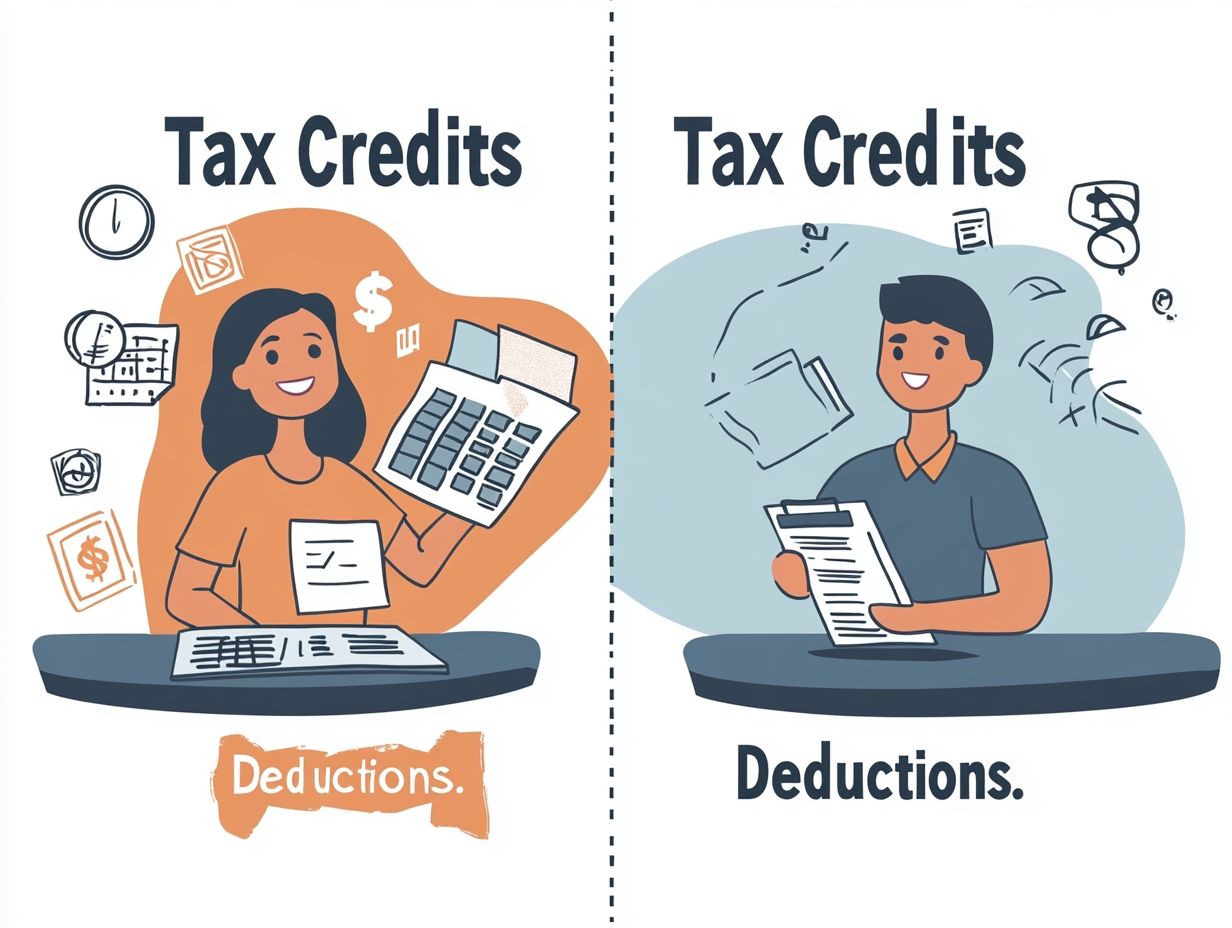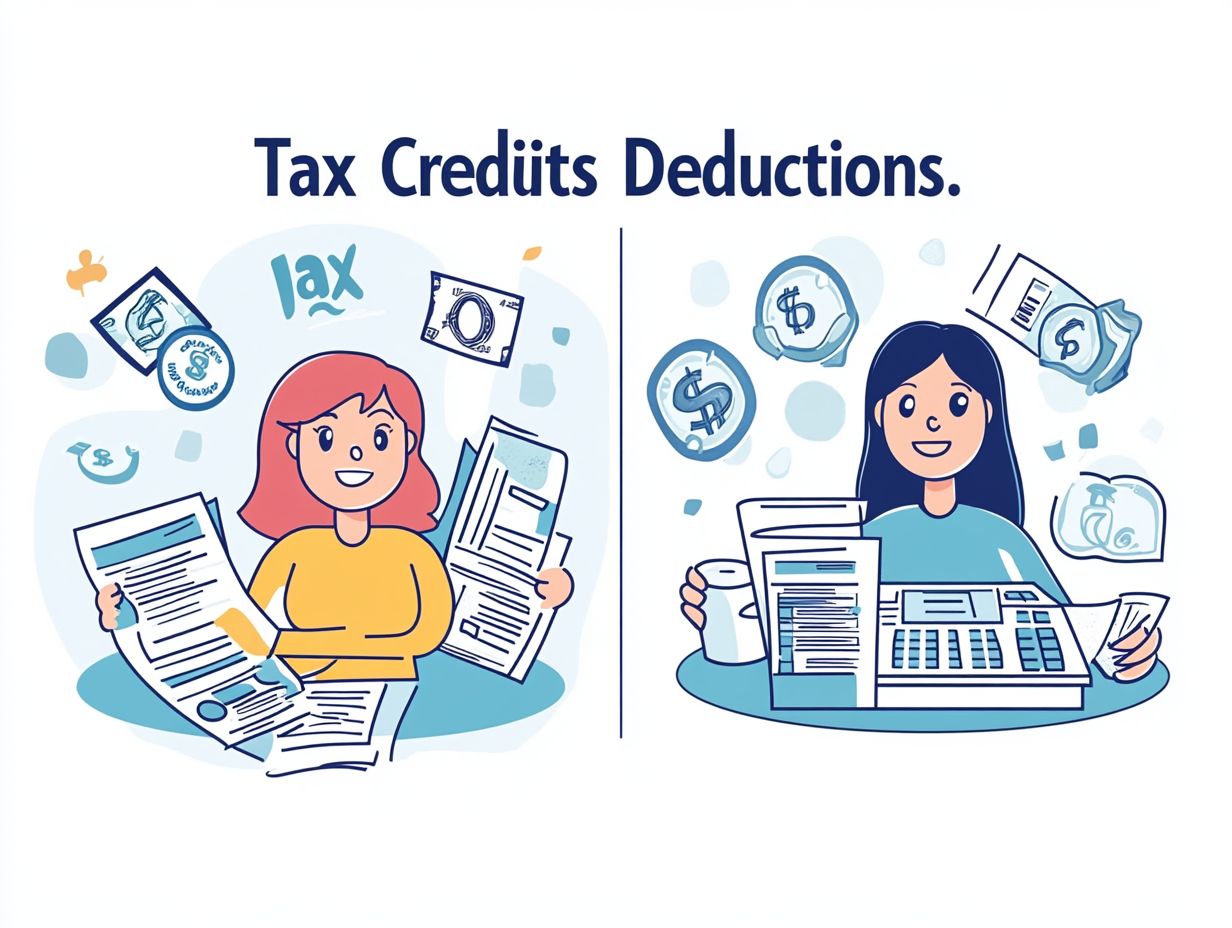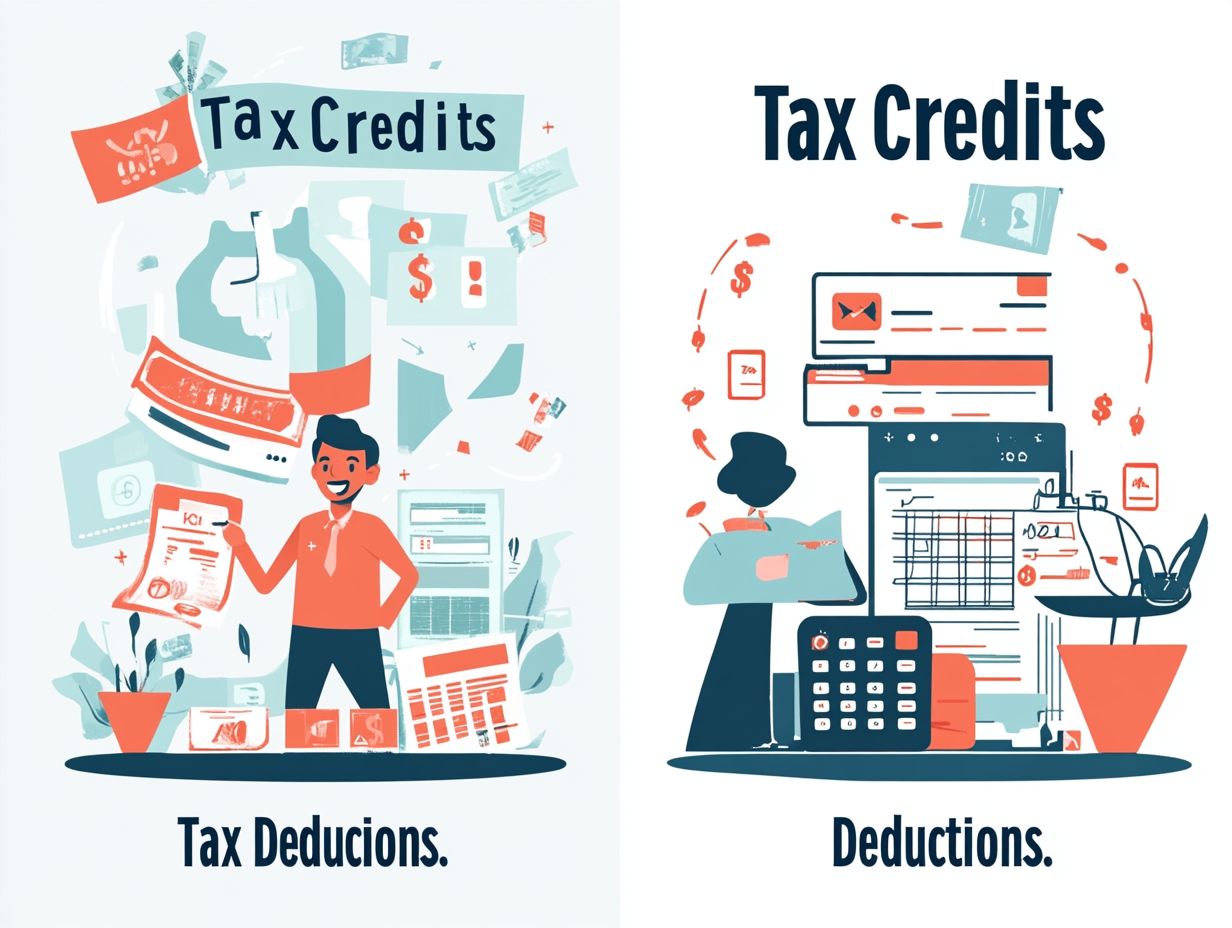What are Tax Credits vs Deductions?
Navigating taxes can feel overwhelming, but understanding tax credits and deductions can lead to big savings! Particularly when it comes to understanding the differences between tax credits and tax deductions.
While both can significantly affect the amount you owe in taxes, they each serve unique functions and can unlock different avenues for savings. This guide explains the definitions and key differences between tax credits and tax deductions, presenting real-world examples and offering strategies to optimize your tax savings.
Whether you re a seasoned filer or just starting your journey, this information is designed to empower you to take full advantage of your financial landscape.
Contents
Key Takeaways:

- Tax credits are direct reductions of the taxes you owe, while deductions reduce your taxable income.
- While both can lower your tax liability (the amount you owe in taxes), tax credits are generally more beneficial because they directly decrease the amount you owe.
- Maximize your tax savings by taking advantage of both tax credits and deductions for individuals and using strategic tax planning.
Understanding Tax Credits and Deductions
Understanding tax credits and deductions is vital for anyone looking to minimize their tax liability while maximizing potential savings. Tax credits can directly reduce what you owe to the government, while tax deductions work to lower your taxable income, ultimately shaping your financial landscape.
The Inflation Reduction Act of 2022 introduced many credits and deductions that can significantly affect your taxes, including education credits and clean vehicle credits. It’s essential for you to stay informed about the options available. From the Earned Income Tax Credit to various education credits and charitable contributions, a wealth of opportunities exists for you to refine and optimize your tax strategy.
What are Tax Credits?
Tax credits are valuable financial incentives that the government offers to reduce your total tax liability. They come in two flavors: refundable and nonrefundable. Refundable tax credits, like the Earned Income Tax Credit, allow you to receive a refund if the credit exceeds your tax liability, meaning you could get money back! In contrast, nonrefundable tax credits only lower what you owe to zero but won t put cash back in your pocket.
These credits are essential tools for managing your finances effectively, especially during the COVID-19 pandemic. Take the Child Tax Credit, for example; it provides significant tax relief to parents, easing their overall tax burden while helping cover child-rearing costs and medical and dental expenses.
Education-related credits, such as the American Opportunity Credit and the Lifetime Learning Credit, also play a vital role by offering financial support to students and their families, making higher education more attainable.
By grasping the differences between refundable tax credits and nonrefundable tax credits, you can make informed financial decisions that maximize your potential savings come tax season.
What are Tax Deductions?
Tax deductions play a pivotal role in reducing your taxable income, which ultimately translates to a lower overall tax liability. You can categorize these deductions into standard and itemized options. The standard deduction provides a fixed reduction based on your filing status, while itemized deductions allow you to deduct specific expenses, such as healthcare expenses and charitable contributions.
As you consider your options, you’ll likely weigh the benefits of the standard deduction against itemized deductions to see which one offers greater savings. For example, eligible expenses for itemization may include:
- Mortgage interest
- Property taxes
- Certain unreimbursed medical expenses that exceed a specific percentage of your adjusted gross income
Understanding IRA deduction limits is also essential, as contributions to traditional IRAs and health savings accounts can qualify for deduction, potentially further reducing your taxable income. By comprehensively evaluating these factors, you can make more informed decisions that may lead to significant tax savings.
Don’t miss out on potential savings! Start exploring your tax options today!
Key Differences Between Tax Credits and Deductions

Understanding the key differences between tax credits and tax deductions is essential for effective tax planning. Tax credits reduce what you owe immediately, while tax deductions lower your taxable income, providing money-saving benefits.
For example, a refundable tax credit means you can get money back if it s more than what you owe. In contrast, a nonrefundable tax credit only offsets your tax liability. It’s crucial to grasp how these concepts interact with both standard and itemized deductions to make informed financial decisions.
Definition and Purpose
The essence and purpose of tax credits and deductions center around alleviating your tax liability. Tax credits provide you with direct dollar-for-dollar reductions on the taxes you owe, while deductions for individuals serve to lower your taxable income, allowing you to keep more of your hard-earned money.
Both tax credits and deductions are instrumental in effective tax planning, enabling you to navigate the intricacies of your financial landscape. By using these tools wisely, you can maximize your savings and improve your cash flow. Working with a financial advisor can prove invaluable; they can analyze your unique circumstances and recommend applicable credits and deductions, including what are tax deductions?, TurboTax, and SmartAsset, that align with your financial objectives.
This approach not only optimizes your tax liability but also reveals practical applications of tax planning that can yield substantial future savings. Collaborating with a knowledgeable advisor can lead to informed decisions and financial strategies tailored specifically to your needs.
How They Affect Your Tax Liability
Tax credits and deductions significantly impact your tax liability by changing the amount you owe to the government. Tax credits provide a direct reduction in your tax bill especially refundable credits, which can even lead to a refund. In contrast, deductions lower your taxable income, which can decrease your overall liabilities and enhance your tax planning.
If you’re eligible for a $1,000 tax credit, your tax owed drops by that same amount, delivering immediate relief an advantage in Opportunity Zones (areas with tax benefits for investments). Alternatively, if you have a $1,000 deduction, it reduces your taxable income, lowering your taxes payable depending on your tax bracket. For example, if your taxable income falls within the 20% bracket, that deduction would only reduce your tax liability by $200.
Therefore, it s vital to evaluate both options, including healthcare expenses, when preparing for tax season. The implications differ significantly and can influence your financial planning throughout the year.
Examples of Tax Credits and Deductions
Examples of tax credits and deductions illustrate how these tools can help you save money and enhance your tax situation. The Child Tax Credit and the Earned Income Tax Credit are significant tax credits that directly reduce the taxes you owe.
Meanwhile, deductions for charitable contributions and healthcare expenses work to lower your taxable income, allowing you to maximize your savings effectively.
Common Tax Credits

Common tax credits can be helpful tools, such as the Earned Income Tax Credit, which is tailored for low to moderate-income taxpayers. The Child Tax Credit supports families with dependent children.
If you re pursuing higher education, education credits like the American Opportunity Tax Credit and the Lifetime Learning Credit can offer substantial savings. Clean vehicle credits reward you for choosing eco-friendly transportation.
These credits can lead to amazing savings, making it easier for you and your family to manage financial responsibilities. For example, the Earned Income Tax Credit can provide a refund of up to several thousand dollars, depending on your income and the number of children you have. The Child Tax Credit may lower your tax by up to $2,000 for each qualifying child.
If you re in the education sector, the American Opportunity Tax Credit provides up to $2,500 for qualifying expenses during the first four years of higher education. The Lifetime Learning Credit can give you up to $2,000 annually for various educational pursuits. Furthermore, clean vehicle credits can save you thousands on your electric or hybrid car purchase.
Common Tax Deductions
Common tax deductions include the standard deduction, which simplifies the filing process for many, and itemized deductions, which means you list specific expenses to reduce your tax. You can choose between these options to maximize your deductions based on your financial situation.
Understanding the difference between these two types of deductions is essential for effective tax planning. The standard deduction provides a fixed dollar amount that reduces your taxable income, while itemized deductions allow for a detailed account of qualifying expenses.
For instance, eligible expenditures for itemization might include:
- Mortgage interest
- State and local taxes
- Medical expenses that exceed a certain percentage of your adjusted gross income (AGI your total income after deductions)
- Donations to qualifying charitable organizations
Therefore, it’s wise to evaluate your expenses carefully to determine whether itemizing offers a more substantial tax benefit than opting for the standard deduction.
Maximizing Your Tax Savings
Maximizing your tax savings requires a strategic approach to utilizing available tax credits and deductions, allowing you to minimize your tax liability effectively.
Working with a financial advisor can illuminate opportunities such as education credits and charitable contributions, refining your tax strategy and amplifying your savings.
Strategies for Using Tax Credits and Deductions
Effective strategies for leveraging tax credits and deductions can significantly reduce your tax liability while enhancing your financial well-being. Engaging a financial advisor can be invaluable in helping you navigate the complexities of available credits and deductions, including those often overlooked, such as moving expenses and dependent care deductions.
Understanding the timing for claiming these benefits is crucial, as certain credits may only be available during specific application windows. Each credit typically has its own unique eligibility requirements, influenced by factors such as your income level, family size, and filing status.
By meticulously organizing your tax documents and staying informed about policy changes, you can ensure compliance while maximizing your claims. Utilizing tax software or consulting with professionals can reveal opportunities that may not be immediately obvious, enabling you to fully capitalize on the financial advantages that tax credits and deductions present.

Frequently Asked Questions

What are Tax Credits vs Deductions?
Tax credits and deductions are two ways to reduce your taxable income and potentially lower your tax bill. Both can be beneficial, but they work differently.
Explore these tax credits today and see how much you can save!
How Do Tax Credits Work?
Tax credits directly reduce the amount you owe in taxes. For example, if you have a $1,000 tax credit, it lowers your tax bill by $1,000! This makes them more valuable than deductions.
How Do Tax Deductions Work?
Tax deductions lower your taxable income, which decreases your tax bill. If you claim a $10,000 deduction and are in the 22% tax bracket, you’ll save $2,200!
Common Tax Credits
Common tax credits include the Earned Income Tax Credit, Child Tax Credit, and American Opportunity Tax Credit. These credits can significantly reduce your tax bill if you qualify!
Common Tax Deductions
Popular tax deductions are the standard deduction, mortgage interest deduction, and charitable contributions. They can help lower your taxable income and tax bill.
Limitations on Tax Credits and Deductions
Yes, both tax credits and deductions have limitations. Some credits may phase out at higher incomes, while deductions can have caps on amounts. Understanding these limits is crucial for your tax planning!






